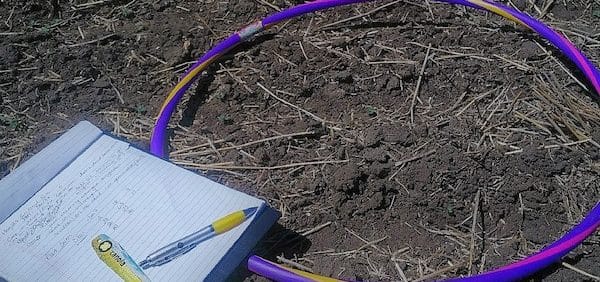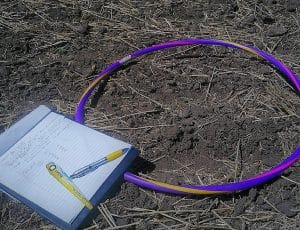To make sure a young canola crop is protected from day one, start scouting at the time when emergence should occur. With warm soils, adequate moisture and 1” seeding depth, emergence can occur about a week after seeding.
When scouting, look for:
Seed survival. Count plants and find out what percentage of the planted seeds emerged by using the ‘emergence’ option under the Seed Rate heading at canolacalculator.ca. Excessive seed-placed fertilizer, seedling diseases, cold/dry soils, insects and other factors can influence seed survival, and unless scouting and counts are done repeatedly through the first few weeks after seeding, these influences may be missed. Understanding your emergence percentage gives you the opportunity to find ways to improve it.
Seeder performance. Rows with poor emergence beside rows with good emergence would suggest a drill problem — maybe due to varying opener depth or plugged lines. Consistent stripes of slower emergence would also indicate an issue with drill leveling, suggesting that part of the drill is seeding too deep.
Insect damage. Flea beetles are usually the most serious insect pest this time of year. Examine newer leaves for recent damage and look for stem feeding. Note that canola seed treatments require a bit of feeding to stop flea beetles, so older leaves may show some damage for this reason while newer leaves may be undamaged – indicating the crop is growing ahead of the feeding and a foliar insecticide application is not likely needed. Cutworms can also remove young canola plants. Look for bare patches and dig around the perimeter of the patch to look for cutworms just below the soil surface. Read the Canola Encyclopedia section on insect issues for plant establishment.
Seedling diseases. Seedling diseases caused by fusarium and pythium species tend to be worse in cool, wet conditions while rhizoctonia tends to be worse when canola emergence is delayed due to cool, dry conditions. The broad spectrum fungicide seed treatments used to treat certified seed typically provide good protection from these seedling diseases. The tell-tale sign of disease is patchy emergence up to the four-leaf stage of the crop. Seeds or seedlings may decay prior to emergence or the seedlings may emerge and appear normal, then stagnate at the two- to four-leaf stages. These plants will often die. Rhizoctonia causes a tapering brown ‘wirestem’ and is often found in deeper seeded fields. Get in the habit of digging up plants and examining their roots whenever you walk your canola fields; this will serve you well throughout the growing season.
Early blackleg. Blackleg affects young canola plants when temperatures have been warm and the soil is moist. The earlier the infection, the higher the yield loss from blackleg. Scout cotyledons, looking for greyish-white lesions speckled with black pycnidia. Severe infections will cause girdling of the stem and premature death of the plant. Distinguishing between seedling diseases and blackleg is difficult to assess. Send plants away to provincial diagnostics lab and monitor symptoms up to harvest to help make better management decisions in future canola crops.
Weeds. Early-season weed competition is the most costly to yield. If fields did not get a pre-seed burnoff, expect to see some weed competition and spray them early in the spray window.
Herbicide damage. Carryover of residual products from last year can be a concern in dry conditions. Mistakes with pre-seed burnoff products can also cause damage. Look for injured plants, patterns of injury and review the field’s spray history.
Fertilizer damage. This can be difficult to diagnose but higher rates of seed-placed fertilizer in dry soils and with low seed-bed utilization (narrow openers and wider rows) can cause seed and seedling mortality. Seeds that are dried up and powder-like inside may be fertilizer damaged. Review fertilizer rates and placement on fields with lower than expected emergence. If you tested your seed placed fertilizer safety this year by shutting it off for a short pass, this area of the crop in the first month may appear better than the rest of the field as early season fertilizer damage holds back the rest of your crop.
Frost. Any amount of frost can start taking out plants. One factor is the daily highs leading up to the frost. If days had been cool (10°C), canola plants may be more acclimatized to a heavier frost. If days had been warm (20°C), even a light frost can cause some seedling death.
Wind. High winds can blow seeds and seedlings right out of the ground, especially if topsoil is dry. Soil-particles blown by the wind can also “sand blast” seedlings.
Residue issues. Thick or uneven residue can have implications for frost damage and reduced seeder performance. With regard to frost, residue means the soil doesn’t warm as much during the day and doesn’t release its stored heat as quickly during the night. Seedlings growing up through heavy residue can therefore be more susceptible to frost. Another factor is that seedlings growing up through residue tend to have longer more exposed hypocotyls, which could increase diseases.


